Brief
 }
}
For many years, corporate strategy languished in banking circles. During the go-go 1990s and most of the 2000s, too many bankers pursued indiscriminate growth, had a broad appetite for risk and diversified their portfolios without worrying enough about controlling costs or staking out distinctive positions in the eyes of customers.
Then, the 2008 financial crisis caused an abrupt about-face from growth to survival. Many bankers wielded blunt restructuring tools to take out costs and deleverage their balance sheets in order to meet regulators’ capital adequacy requirements. While most of these measures were necessary, they certainly did not set the stage for future growth. The majority of banks relied on the same tactics of cost takeout, branch network pruning and performance improvement over the past five years, yet the industry’s return on equity dropped by 6 percentage points since before the crisis, and continues to decline (see Figure 1).
The times demand that banks relearn strategy. Banks’ sources of revenue have come under pressure: Credit growth has slowed as consumers and businesses have deleveraged, net interest margins have been squeezed, and fee income has come under pressure due to increased competition and consumer watchdogs’ focus on unfair practices. At the same time, new digitally based entrants with disruptive business models, such as eToro and Kabbage, have been attacking lazy profit pools and taking share from incumbent banks. Several waves of regulation have introduced ever stricter and higher capital requirements, reducing banks’ own balance sheet leverage.
The new macro and competitive environment means that banks have to adapt through more disciplined strategy. At some banks, what passes for strategy, in fact consists of the pursuit of quarterly profit targets. A long-term growth strategy, by contrast, often means enduring some pain over the short term and explaining to shareholders why it takes time to deliver results.
To be sure, many challenges today—including low interest rates, high nonperforming loans in some countries and a regulatory backlash in many regions—have some element of cyclicality. Observers taking an extreme position could argue that banks in southern Europe will continue to lag no matter what their strategy is and that US banks can expect stronger growth once interest rates rise. Bankers who buy the cyclical explanation might feel as though they have limited options or should not make material changes.
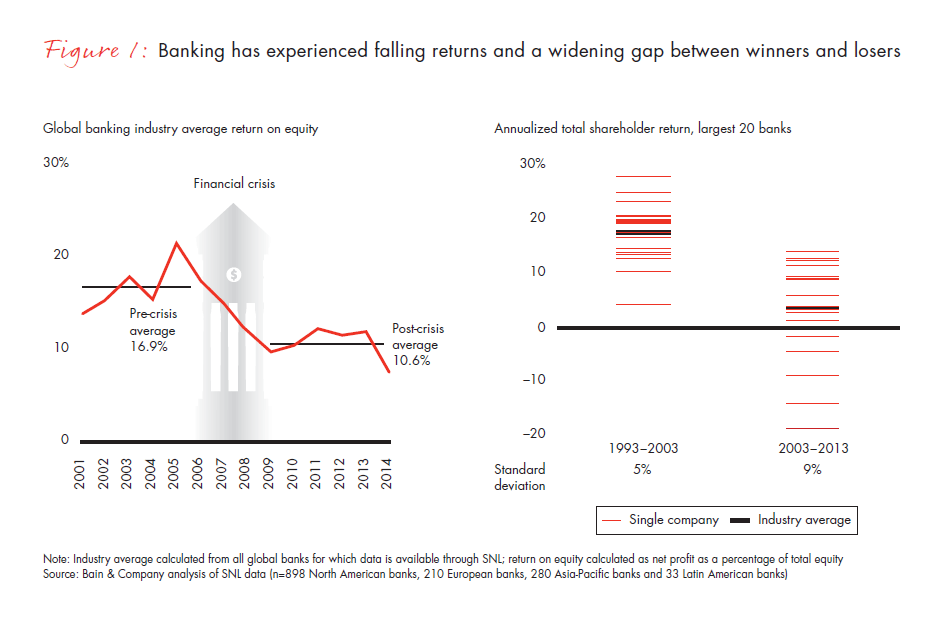
We believe that cyclical effects, though real, do not present a complete picture. Some banks perform better than others in the same conditions, and the winners over long periods manage the structural as well as the cyclical elements.
Consider that the gap in total shareholder return between the best and worst of the 20 largest banks worldwide has widened from a 5% standard deviation from the average return between 1993 and 2003 to 9% over the 2003–2013 period. Clearly, different business choices led to different financial outcomes.
For many banks, then, a last call for creating a sustainable advantage is approaching. They will need to stretch dormant strategy muscles at the enterprise level. This goes well beyond ranking current businesses based on their financial contribution, because that exercise cannot predict what will deliver future returns.
The old, blunt strategic playbook took a resource-led approach to the portfolio that ranked businesses within existing constraints of risk, capital and liquidity, leading to short-term (one- to two-year) planning. A more effective approach to strategy defines decisions that can distinguish the bank from competitors in the eyes of customers and that allow the bank to beat competitors through cost leadership, superior customer service or other means. This approach takes a three- to five-year planning horizon, with a target portfolio that determines risk, capital and liquidity boundaries.
Now facing low interest margins and low growth, many banks must relearn strategy. Niels Peder Nielsen, a partner in Bain's Financial Services practice, explains how in this short video.
Writing a new playbook requires making real choices
Any strategy should take into account the starting point and the customer, competitive, technological and regulatory trends affecting a bank and its markets. It should also equip the bank to manage through financial market and economic cycles, being explicit about the risk exposures desired and how to adjust those exposures throughout the cycle. Accomplishing both goals entails defining a much broader set of options than most banks have considered regarding their business portfolio, risk appetite and capital allocation.
Strategy should define the attractive markets and whether a bank can develop a strong and sustainable position in those markets so that it can build a few distinctive assets and capabilities that set it apart. Differentiation comes not from baseline steps such as moving activities online but rather by sculpting features that will induce customers to take out a mortgage or invest their wealth with one bank over its competitors.
Making choices about what type of bank to become is a central issue for all banks today. Bain’s analysis of 250 banks globally shows that only 1 in 9 are sustained value creators—we define this group as banks that beat the competition on revenue and earnings growth over the 10-year period, while delivering total shareholder return greater than the cost of capital.
In our sampling, 65% of the sustained value creators (by number of banks) are local or regional, multi-category banks. By contrast, only 4% of sustained value creators fit the global universal model, which is a smaller share than the 7% of total banks that fit the global model (see Figure 2). Most of the global universal banks extended their footprint so broadly that they now have a long tail of subscale countries or products that don’t yield leadership economics. For years, given positive macroeconomic trends and reasonable growth in emerging markets, global universal banks were not required to prove that synergies of scope, scale and funding exceeded the potential drawbacks of complexity and control challenges. However, slower economic growth, increasingly sophisticated local competitors and recent regulatory changes have imposed significant penalties for being global and universal. That forces global universal banks to reassess the value of this model.
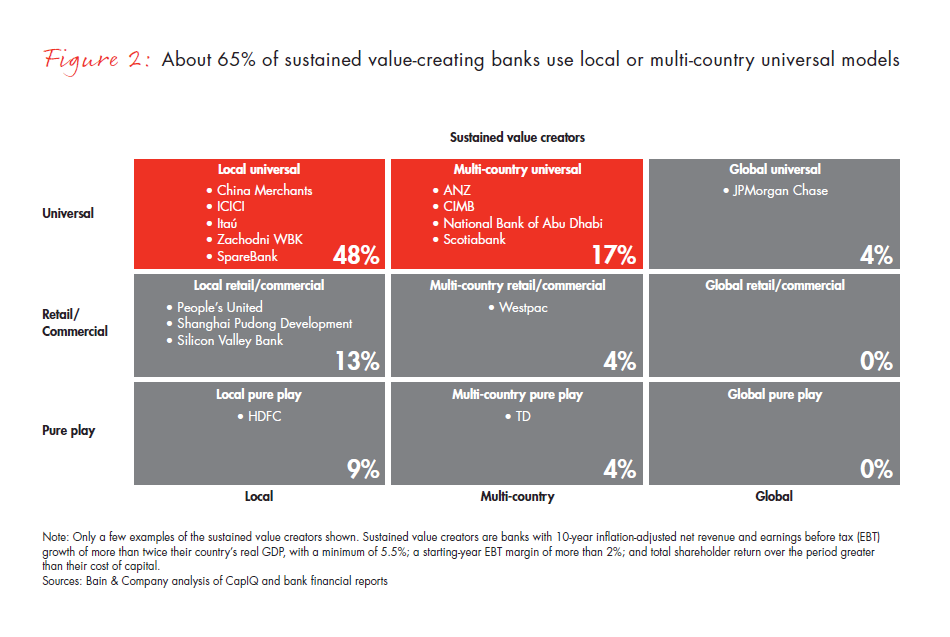
The result: The 3-percentage-point return on equity advantage over other banks that global universal banks once enjoyed due to synergies has been reversed, with some global banks posting an ROE disadvantage as large as 3 percentage points, according to Bain analysis. Now, a few global universal banks, such as Royal Bank of Scotland and Deutsche Bank, have started to move away from—or adapt—the model, exiting countries and splitting off large business units. Others, such as JPMorgan Chase and HSBC, conceding that the penalties have shifted the balance, seek to make conscious choices to ensure that the economics are sustainable.
Customers notice these choices. In retail banking, for instance, large national banks’ Net Promoter ScoreSM, a well-established measure of customer loyalty, in some countries still lags behind direct banks, cooperatives and credit unions—institutions that tend to have clear, focused strategies and that explicitly choose not to do certain things so that they can excel at their core offerings.
Some leading banks, therefore, are making strategic choices from a set of options that feel radically different from one another, rather than being a variation on a theme. Their decisions cluster in three areas: the bank’s overall ambitions; where it should play by country, product and customer segment; and how it can win in each chosen market (see Figure 3).
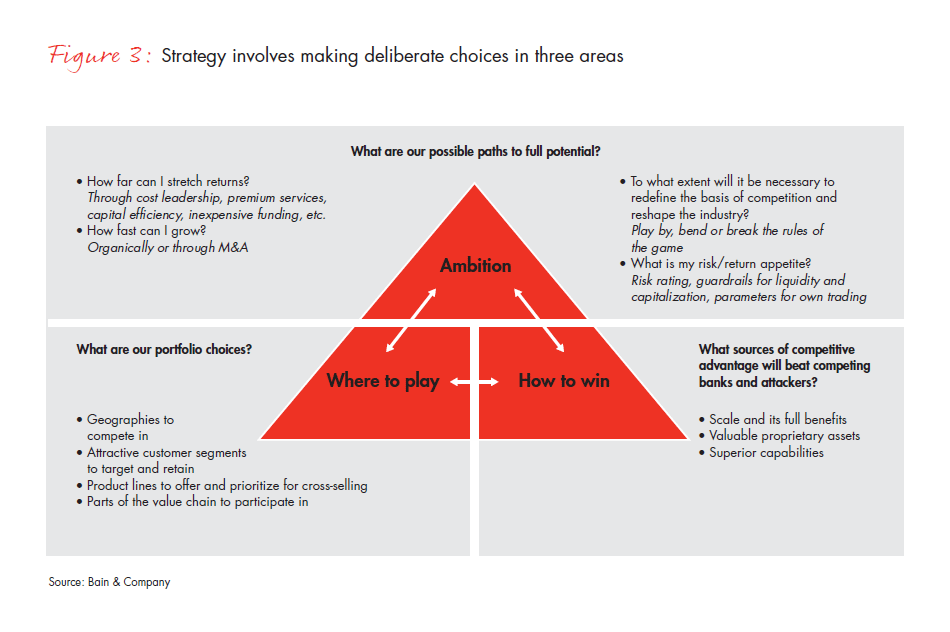
What’s your ambition?
Setting a bank’s ambition at the enterprise level involves articulating a vision that’s both inspiring for employees and specific enough to enable choices as opposed to vague, feel-good aspirations. The vision can encompass what the mix of businesses and geographies will look like and the desired competitive position.
Commonwealth Bank of Australia (CBA), for instance, has the stated ambition of being Australia’s finest financial services organization through excelling in the customer experience. That vision shapes how CBA designs its propositions around the customer’s perspective— for example, designing its service around the entire event of “buying a home” rather than the narrower act of “selling a mortgage.”
Besides a compelling vision, defining the ambition involves choices concerning what balance of risk and return to adopt. This will depend partly on investors’ appetite for risk. Rabobank, a member-owned cooperative bank in the Netherlands, has defined its risk and return objectives consistent with its members’ appetite. “Rabobank’s business strategy is based on its cooperative background,” the bank says, “and thus maximization of profit is not an objective.”
Where should you play?
Once the ambition is set, what should the business portfolio mix look like in terms of geographic focus, customer segments, product lines and parts of the value chain? Just as important, what links the businesses and could make the whole worth more than the sum of the parts? This question concerns not only cost and platform sharing or customer overlaps. Liquidity and funding have always been crucial in a balance-sheet business, but new regulations and near-death experiences should force bankers to more explicitly consider tradeoffs and asset/liability linkages.
When weighing whether to keep or add a country or a product line, it makes sense to set a high hurdle. For instance, if you are the No. 5 player in Brazil, with relatively few international synergies and a lot of capital required to break into the top 3, exiting may be the best option.
Choosing which customer segments to serve requires a rigorous review of how capital and management resources would be allocated across consumers, small businesses, multinational corporations and the sub-segments within each one. In small business lending, for instance, it is becoming increasingly important to pursue fee-based transactional activities such as cash management. In consumer markets, few banks can be all things to all people, so it may be better to exit serving a particular segment if you cannot deliver a differentiated experience.
For any given product or segment, banks also have a range of choices about how to source and deliver the goods—their own product, a co-branded product, third-party investment vehicles, in-house vs. outsourced processing and so on. Royal Bank of Canada distributes asset management products through third parties and outsources investor/treasury services, for example, yet manages to lead in almost all categories in which it competes.
Viewing the portfolio in an integrated manner allows a bank to choose the best businesses to pursue and avoid less attractive, subscale businesses. You can build this view based on an assessment of each business’s attractiveness, using metrics such as return on capital and segment growth, and the bank’s ability to win, using metrics such as relative market share and relative customer loyalty scores (see Figure 4). Then you can set a strategy for each business and allocate resources appropriately.
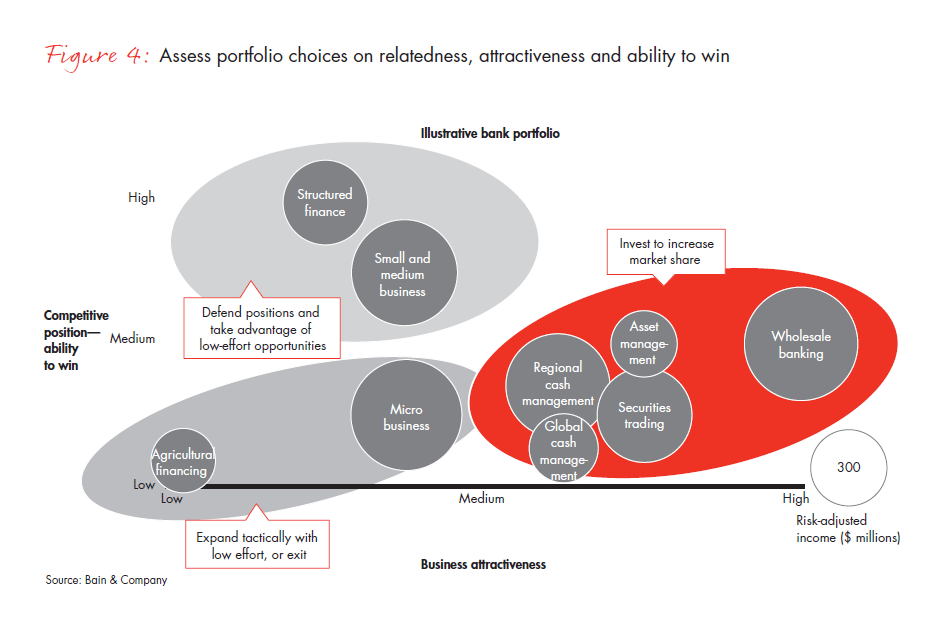
How can you win?
When banks make deliberate choices about where to play, some banks often then jump right to tactical steps. Most sustained value creators, by contrast, first spend time determining how they can win—for instance, how to become a trusted proposition in small business lending and ancillary services, or which aspects of the banking experience will truly delight their retail consumers and improve the bank’s economics.
Distinctive how-to-win models in banking include product innovation (as pursued by China Merchants Bank), efficiency (Santander) and repeatable mergers and acquisitions. While the models are not mutually exclusive, each depends on a different mix of key assets and capabilities. It’s difficult and resource-intensive to be great at every capability; in fact, it’s not necessary or even healthy. Leading banks invest heavily in those few capabilities essential to realizing the strategy while being “good enough” where that’s sufficient (see Figure 5).
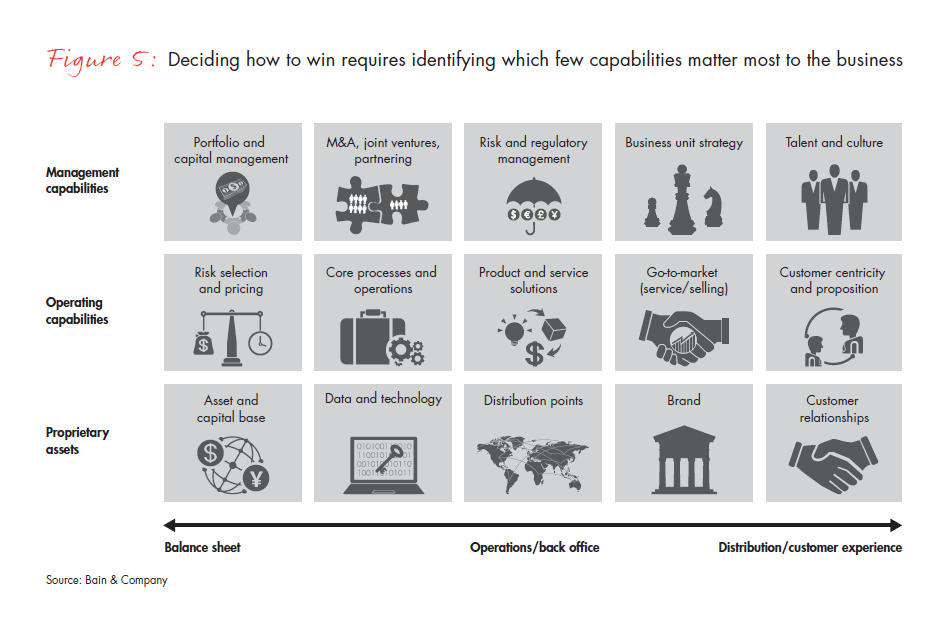
Santander illustrates the power of a clear focus on local scale and an industrial operating model. As one part of its growth strategy, Santander has built a portfolio of retail leadership positions in Spain and Latin America, all characterized by efficiency derived through standardized operations and a shared global IT platform. Santander excels in a few capabilities—particularly, M&A, sales, operations and IT—that enable it to both target underperforming retail banks for acquisition as well as spur incremental performance improvement across the portfolio (see Figure 6).
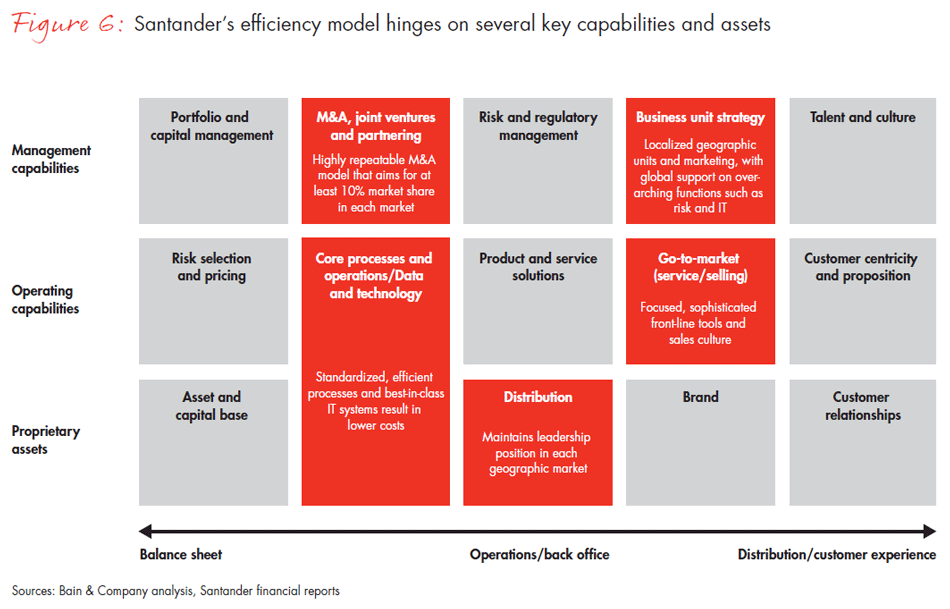
Strategy was dead, long live strategy
The need to make strategic choices for long-term growth and performance has become more urgent for banks than their leaders may realize. Customers are increasingly willing to try disruptive models such as peer-to-peer lending or non-card payments systems. Local competitive dynamics also are changing—for instance, in developing markets, homegrown banks have been introducing more sophisticated services just as global banks retreat. At the same time, many of the strategic choices that banks will make have big implications for investments in technology and talent, and will take time to implement.
These changes demand more from leaders at the corporate center. For example, they will need to develop a better understanding of the real profitability of their businesses, adjusted for risk and capital requirements. While banks frequently used risk-adjusted return on capital measures in the 1990s, many moved in the early 2000s to a focus on operating profit, then moved to revenue or even volume of assets, which encouraged indiscriminate growth. Some banks only reestablished a focus on return on capital measures after the financial crisis. Most banks could also stand to improve their policies on transfer pricing, capital allocation and incentives for executives and staff.
A great strategy will stall without effective implementation, of course, and banks face substantial challenges here as well. They have to deal with interlinked flows of capital and legacy IT systems that create interconnections and make it tough to unwind particular businesses.
Yet with market dynamics expanding the gap between winners and losers, banks have nowhere left to hide. The proliferation of digital attackers, combined with innovations such as peer-to-peer lending and international payments solutions, are accelerating the pace of competitive change. Those banks that move quickly to define focused and distinctive strategic paths and priorities will be able to control their destiny. Those that hesitate or hope for the cycle to swing in their favor risk running out of time and being caught wrong-footed as the market evolves.
James Hadley leads Bain & Company’s Strategy practice in Europe, the Middle East and Africa. He is based in London. Niels Peder Nielsen, Thomas Olsen and Gary Turner are partners in Bain’s Financial Services practice, and they are based, respectively, in Copenhagen, Singapore and Sydney.





